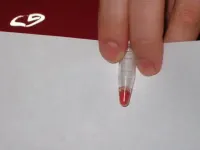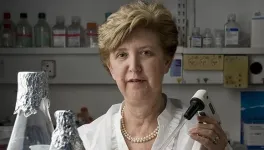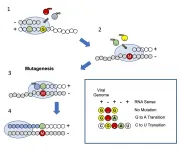(Press-News.org) It took an unlikely food innovation -- earth-friendly vegetarian patties, made to taste and "bleed" like the familiar meaty ones -- to make people aware of heme.
But heme is an essential part of proteins found in most life forms, from tiny bacteria to soy plants to the human body. Heme plays a crucial role in supplying cells with the energy needed to carry out chemical reactions.
In human cells, iron-containing heme is the essential cofactor of two types of molecules. One is the hemoglobin molecules that bind oxygen in the lungs and ferry it around the body. More than half the heme in the body is in hemoglobin, but some of the rest is in the hemeproteins called cytochromes.
New research from Washington University in St. Louis in the journal eLife shows how animals and bacteria differ in the enzyme they use to attach heme to the cytochrome. Spotting variations in how this "cytochrome c synthase" works would help to find compounds that deactivate the enzyme in bacteria, but not in humans. The results of this study demonstrate that the bacterial cytochrome c synthase could be a promising target for new antibiotics.
However, studying cytochrome c synthase in living cells is challenging.
"We took purified CcsBA [a protein for making cytochrome in bacteria] and purified human HCCS and, with an assay in a test tube, attached the heme to the cyt c or cyt c peptides," said Robert Kranz, professor of biology in Arts & Sciences and senior author of the new paper. "This allows us to say what each (CcsBA and human HCCS) recognizes on the cytochrome to attach the heme. It further shows that the peptides can inhibit attachment to the cytochrome by HCCS.
"No one else has purified CcsBA or human HCCS, or analyzed the reaction in vitro," Kranz said.
In addition to this first-of-its-kind research, Kranz led the group of Washington University scientists that previously discovered how the vital but vulnerable heme molecule is shuttled across cell membranes for cytochrome synthesis.
For the new work, the scientists examined in detail which structures the enzymes recognize to attach the heme onto their cytochrome target. Their experiments revealed that human and bacterial synthases actually rely on different parts of the cytochrome c to orient themselves. Different short compounds could block either the human or bacterial enzyme.
Variations between human and bacterial cytochrome c synthase could lead to new antibiotics that prevent cytochrome assembly and kill bacteria while sparing patients. A provisional patent application has been filed for the process by the Washington University Office of Technology Management.
"The project represents seven years of effort," said Molly C. Sutherland, one of three co-first authors of the paper, who is now an assistant professor of biological sciences at the University of Delaware. Sutherland said that she and co-authors Shalon E. Babbitt and Deanna L. Mendez were able to "work collaboratively, bring individual expertise and build off each other's results.
"This combined effort -- along with some talented undergrads! -- is the reason that we were able to analyze the human and bacterial holocytochrome c synthases at such a detailed level," Sutherland said.
Heme helps ferry oxygen throughout the body, carries iron and colors blood red. For most humans, the majority of the heme we consume comes from animals.
But plants also make heme. Plants use CcsBA in their chloroplasts -- the organelle that conducts photosynthesis -- and they cannot grow without cytochrome proteins. Because of this dependency, Kranz and his team are also looking at how they could block cytochrome processes in plants to build smarter herbicides.
Which bring us back to the heme in those veggie burgers. The company Impossible Foods discovered that heme in red meats catalyze (during cooking) many of the reactions that form the tasty flavors that meat-loving humans crave. A question raised by some at that time was whether heme -- as an added "magic" ingredient -- was safe. But because all plants have heme, humans ingest it every day -- even vegetarians. It is just at higher concentrations in red meat.
"Heme has been consumed by humans and other animals for a long time with no issues," Kranz told Business Insider at the height of the Impossible Burger craze.
So whether functioning as the magic ingredient in plant-based burgers or as an essential co-factor for cytochromes and hemoglobins, being able to control processes that use heme will lead to advances in health and agriculture. The potential use in new antibiotics is perhaps the most exciting for Kranz and his team.
"Now, we see how we might be able to target heme to starve bacteria by cutting off their energy sources," Kranz said. "The next step is to identify the molecules that specifically interfere with cytochrome synthase in bacteria."
INFORMATION:
ALBUQUERQUE, N.M. -- Two groups of researchers at Sandia National Laboratories have published papers on the droplets of liquid sprayed by coughs or sneezes and how far they can travel under different conditions.
Both teams used Sandia's decades of experience with advanced computer simulations studying how liquids and gases move for its nuclear stockpile stewardship mission.
Their findings reinforce the importance of wearing masks, maintaining social distancing, avoiding poorly ventilated indoor spaces and washing your hands frequently, especially with ...
Trinity study finds people homeless in their 20s, 30s and 40s are physically comparable to those housed in their 70s and 80s
A Trinity College study published today (Monday, 10th May 2021) demonstrates an extremely high burden of physical and mobility problems experienced by people who are homeless and were admitted for inpatient care to an acute hospital in Dublin. The study found that only one third of participants could climb a hospital stairs and there was a very common presentation of geriatric conditions such as frailty, falls and needing a mobility aid on a long term basis, despite a low median participant age of 45 years.
The study is published in the journal Scientific Reports here: http://www.nature.com/articles/s41598-021-88590-0
Overall ...
Dental and orthopedic implants are widely used around the world. Common causes for implant failure are the immune response against oral bacteria and titanium particles shed by the implant. These and other phenomena can generate an inflammatory response, activating the osteoclasts (bone resorbing cells), and ultimately leading to osteolysis (destruction of bone tissue) around the implants. After this process begins, it is almost impossible to control, eventually leading to loss of the implant. A similar process occurs around natural teeth, with bacteria as the main cause, and bone resorption triggered by the immune response and inflammatory cells.
Researchers from Tel Aviv University have developed ...
LAWRENCE -- The COVID-19 pandemic has presented a new world of challenges for education. But a new study from the University of Kansas shows the voices and experiences of students who are already among the most marginalized can help lead the way in making young people's strengths the focus of education.
Students with disabilities already faced a disproportionate amount of inequities in the American educational system before the pandemic. Researchers interviewed students in this population about their experiences during the pandemic and found that students relied on their own strengths, resilience and self-determination. The findings not only highlight the importance ...
Extreme weather is harming UK agriculture - but many farmers have not yet made adapting to the effects of the climate emergency a priority, a new study shows.
All farmers who took part in the research said they had experienced or witnessed issues caused by extreme weather such as heavy rain or prolonged dry spells in recent years, and expected these to intensify further.
Many were concerned about the impact of heat and drought on crop and grass growth, with knock-on impacts for yield and winter animal feed, and the implications of heavy rainfall/flooding for soil run-off and erosion and for field operations such as drilling and harvesting. ...
Greater Presence of Family Physicians, Midwives May Be Key Component to Decreasing Cesarean Delivery Rates
Surgical cesarean births can expose new mothers to a range of health complications, including infection, blood clots and hemorrhage. As part of Healthy People 2020 and other maternal health objectives, the state of California exerted pressure to reduce cesarean deliveries, and statewide organizations established quality initiatives in partnership with those goals. In this study, researchers from Stanford University and the University of Chicago examined unit culture and provider mix differences on hospital and delivery units to identify characteristics of units that successfully reduced their cesarean delivery rates. The mixed-methods study surveyed ...
SALT LAKE CITY - Today in Nature Communications, researchers at Huntsman Cancer Institute at the University of Utah report critical new insights into how cells mount an attack against melanoma tumors.
Melanoma is an aggressive type of skin cancer that can arise from excess exposure to sun, frequent sunburns, genetics, and other environmental factors. Melanoma, like all cancers, begins within cells. Specially designed and refined over billions of years, cells are experts at working to root out and fix routine errors that arise. A tumor begins when a cell makes faulty copies of itself over and over again. If left unchecked, these faulty cell copies ...
A new Dartmouth Engineering study shows that integrating renewable energy into the American Electric Power System (AEPS) would enhance the grid's resilience, meaning a highly resilient and decarbonized energy system is possible. The researchers' analysis is based upon the incremental incorporation of architectural changes that would be required to integrate renewable energy into AEPS.
The paper, "A Hetero-functional Graph Resilience Analysis of the Future American Electric Power System," was recently published by IEEE Access.
"We concluded that there are no structural trade-offs between grid sustainability and resilience enhancements, meaning these strategic goals can be pursued ...
A biochemical reaction between an enzyme called luciferase and oxygen causes fireflies to glow and is considered one of the most well-known examples of bioluminescence in nature. Now, an international team of researchers led by Elena Goun at the University of Missouri is working to harness the power of bioluminescence in a low-cost, noninvasive portable medical imaging device that could one day be applied to many uses in biomedical research, translational medicine and clinical diagnoses.
Potential uses include developing better treatments for cancer, diabetes and infectious diseases, along with monitoring various metabolic functions, such as gut health, in both animals ...
A University of Alberta virology lab has uncovered how an oral antiviral drug works to attack the SARS-CoV-2 virus, in findings published May 10 in the Journal of Biological Chemistry.
The researchers demonstrated the underlying mechanism of action by which the antiviral drug molnupiravir changes the viral genome, a process known as excessive mutagenesis or “error catastrophe.”
“The polymerase, or replication engine of the virus, mistakes molnupiravir molecules for the natural building blocks required for viral genome replication and mixes them in,” ...




